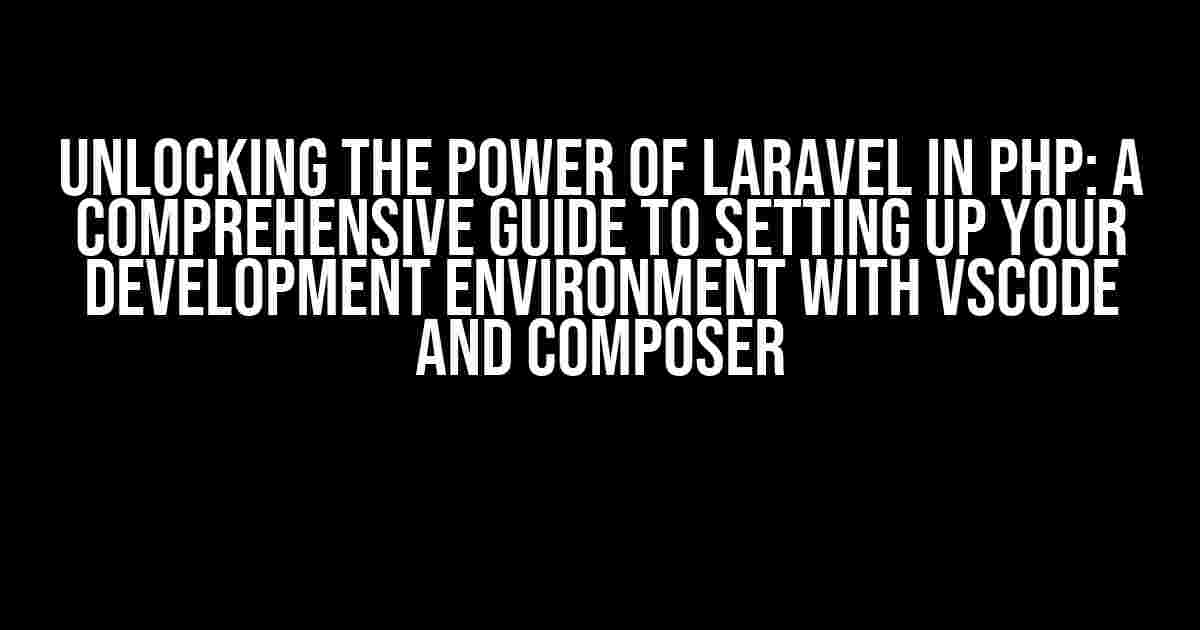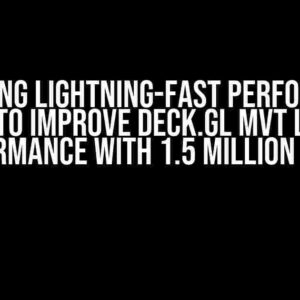As a PHP developer, you’re probably no stranger to the world of Laravel, one of the most popular and widely-used PHP frameworks out there. But are you taking full advantage of its capabilities? In this article, we’ll explore how to set up your development environment with VSCode and Composer, and unlock the full potential of Laravel in PHP.
Why Laravel?
Laravel is an open-source PHP framework that offers a robust set of tools and features to build robust, scalable, and maintainable web applications. With its modular design, expressive syntax, and extensive documentation, Laravel has become the go-to choice for many PHP developers. But what makes Laravel so special?
- Modular Architecture: Laravel’s modular design allows you to build applications that are highly scalable and maintainable, making it easy to add or remove features as needed.
- Robust Security Features: Laravel comes with a built-in security system that protects your application from common web vulnerabilities, such as SQL injection and cross-site scripting (XSS).
- Extensive Libraries and Tools: Laravel provides a wide range of libraries and tools to help you build applications quickly and efficiently, including a powerful ORM system, routing, and middleware.
- Large Community and Ecosystem: Laravel has a massive community of developers and a thriving ecosystem of third-party packages and plugins, making it easy to find answers to common problems and stay up-to-date with the latest trends and best practices.
Setting Up Your Development Environment with VSCode and Composer
Now that we’ve covered why Laravel is an excellent choice for PHP development, let’s dive into setting up your development environment with VSCode and Composer.
Installing VSCode
VSCode is a lightweight, open-source code editor that provides a comprehensive set of features for building and debugging PHP applications. To install VSCode, follow these steps:
- Download the VSCode installer from the official website (https://code.visualstudio.com/)
- Run the installer and follow the prompts to install VSCode
- Once installed, launch VSCode and explore its features and settings
Installing Composer
Composer is a popular PHP package manager that allows you to easily install and manage dependencies for your Laravel project. To install Composer, follow these steps:
- Download the Composer installer from the official website (https://getcomposer.org/)
- Run the installer and follow the prompts to install Composer
- Once installed, open a terminal or command prompt and run the command `composer –version` to verify that Composer is installed correctly
Creating a New Laravel Project
Now that we have VSCode and Composer installed, let’s create a new Laravel project. Open a terminal or command prompt and run the following command:
composer create-project --prefer-dist laravel/laravel project-nameReplace `project-name` with the desired name for your project. This will create a new Laravel project with the basic directory structure and files.
Configuring VSCode for Laravel Development
To get the most out of VSCode for Laravel development, we need to configure it to work with our new project. Here are a few settings and extensions you’ll want to install:
- PHP Language Server: This extension provides advanced PHP language features, such as code completion, debugging, and syntax highlighting. Install it by running the command `code –install-extension felixfbecker.php-language-server` in your terminal or command prompt.
- Laravel Extension Pack: This extension pack provides a set of useful features and tools for Laravel development, including code snippets, debugging, and routing. Install it by running the command `code –install-extension ryannaddy.laravel-extension-pack` in your terminal or command prompt.
- VSCode Settings: Open the VSCode settings by pressing `Ctrl + Shift + P` (Windows/Linux) or `Cmd + Shift + P` (Mac) and update the following settings:
| Setting | Value |
|---|---|
| php.validate.enable | true |
| php.suggest.basic | true |
| php.format.choices | psr-12 |
Getting Started with Laravel
Now that we have our development environment set up, let’s dive into Laravel and explore some of its key features and concepts.
Understanding the Laravel Directory Structure
Laravel’s directory structure is designed to be modular and flexible, with each component serving a specific purpose. Here’s a brief overview of the main directories and files:
- app: This directory contains the core application logic, including models, controllers, and requests.
- config: This directory contains configuration files for the application, including database settings and middleware.
- public: This directory contains the public-facing assets for the application, including images, CSS, and JavaScript files.
- resources: This directory contains the application’s templates, views, and language files.
- routes: This directory contains the application’s routing definitions, including HTTP routes and API routes.
- storage: This directory contains the application’s storage files, including uploaded files and logs.
- tests: This directory contains the application’s test files, including unit tests and feature tests.
- vendor: This directory contains the application’s dependencies, including Laravel and other third-party packages.
Creating a New Controller
To get started with Laravel, let’s create a new controller to handle requests and responses. Open the `app/Http/Controllers` directory and create a new file called `HelloController.php`. Add the following code:
<?php
namespace App\Http\Controllers;
use Illuminate\Http\Request;
class HelloController extends Controller
{
public function index()
{
return 'Hello, World!';
}
}
This controller defines a single method, `index`, which returns a simple “Hello, World!” message.
Defining a Route
To expose our new controller to the world, we need to define a route. Open the `routes/web.php` file and add the following code:
Route::get('/hello', 'HelloController@index');
This route defines a GET request to the `/hello` URL, which will be handled by the `index` method of our `HelloController`.
Running the Application
To run our application, open a terminal or command prompt and navigate to the project directory. Run the command `php artisan serve` to start the development server. Open a web browser and navigate to `http://localhost:8000/hello` to see our “Hello, World!” message in action.
Conclusion
In this article, we’ve covered the basics of setting up a Laravel development environment with VSCode and Composer. We’ve also explored some of the key features and concepts of Laravel, including its modular directory structure, controllers, and routing. By following these steps and guidelines, you’ll be well on your way to building robust, scalable, and maintainable PHP applications with Laravel.
Remember, Laravel is a powerful and flexible framework that requires practice and experimentation to master. Don’t be afraid to try new things, explore different approaches, and seek help from the Laravel community when needed. Happy coding!
Frequently Asked Question
Get ready to dive into the world of Laravel, PHP, VSCode, and Composer with our top 5 FAQs that will set you up for success!
What is Laravel, and why is it so popular among PHP developers?
Laravel is a free, open-source PHP web framework that provides a robust set of tools and features to build scalable, secure, and maintainable web applications. Its popularity stems from its ease of use, flexibility, and extensive community support, making it a go-to choice for PHP developers.
How do I set up a new Laravel project in VSCode?
To set up a new Laravel project in VSCode, open a terminal in VSCode, navigate to the directory where you want to create your project, and run the command `composer create-project –prefer-dist laravel/laravel project-name`. Then, open the project in VSCode and start coding!
What is Composer, and how does it relate to Laravel?
Composer is a dependency manager for PHP that allows you to easily install and manage libraries and dependencies for your projects. Laravel uses Composer to manage its dependencies, making it easy to install and update Laravel packages and libraries.
How do I install Laravel extensions and packages in VSCode?
To install Laravel extensions and packages in VSCode, open the terminal in VSCode and run the command `composer require package-name`. You can also use the VSCode extension “Laravel Extension Pack” to easily discover and install Laravel packages.
Can I use Laravel with other PHP frameworks or libraries?
Yes, Laravel can be used with other PHP frameworks or libraries. While Laravel is a full-fledged framework, its modular design allows you to use individual components or packages with other frameworks or libraries, making it a flexible and versatile choice for PHP development.



